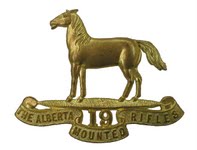 |
|
 |
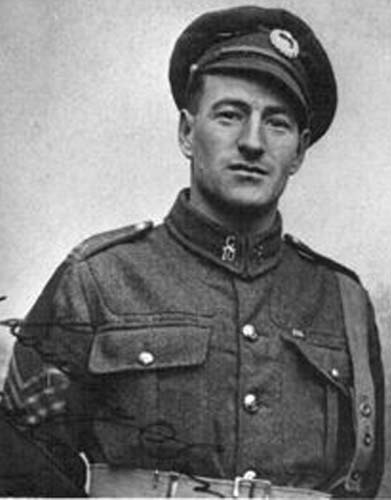
LEONARD EDWARD MELBOURNE, M.M.
Sergeant
2035
19th Alberta Dragoons
10th Battalion, Canadian Expeditionary Force
This photo was taken in France for Christmas 1918, and after his promotion to sergeant on Oct 10, 1918.
The ribbon of the Military Medal is showing on his chest.
Military Service Prior to WWI
In his attestation papers for joining the Canadian
Expeditionary Force, Leonard indicates that he spent two
years in the East Surrey Volunteer Regiment. At that time
Leonard was at the Tiffinian's School in
Kingston-on-Thames, England. That school, like most better
schools of the time, was affiliated with an army regiment,
in this case the East Surreys. That regiment would have
had a territorial battalion which included the school and
we have extant in the family a copy of a track and field
event program, dated July 18 1908 when Leonard was
18, which lists the musical program provided by the
band of the 6th Battalion, East Surrey Regiment band.
Leonard shows himself as a good runner in these events.
Leonard was at the school from the second term of 1905
until July 30, 1908, at the age of 18. In April of 1909,
Leonard went to Canada with his mother and sister to join
his father at Pine Creek (now Waskatenau), Alberta,
Canada.
Military Service in WWI
On 4 August 1914, Canada. as part of the British Empire, entered the war on Germany. The Canadian Government mobilized certain units and created new battalions to provide its support to the war effort. All personnel (even those enlisted in regular or militia units) were required to sign a new commitment to the war effort using a form called an attestation paper. The 19th Alberta Dragoons, and all other personnel destined for the war, were shipped to Valcartier, Quebec where these papers were signed.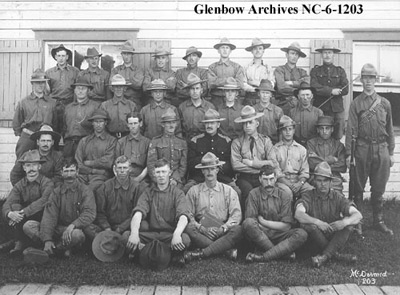 |
| The 19th Alberta
Dragoons, Edmonton 1914 [from the Glenbow Archives] Is Leonard in this photograph? The Lieutenant Colonel in the second (in dress uniform) row is Jamieson, who signed Leonard's attestation papers |
Walter Woods was another member of the 19th Alberta Dragoons who joined just before the war and traveled on the same trip as Leonard. This link is for an excerpt from his book "The Men Who Came Back" covers some of that trip and gives a good description of the activities of the 19th until arrival in France.
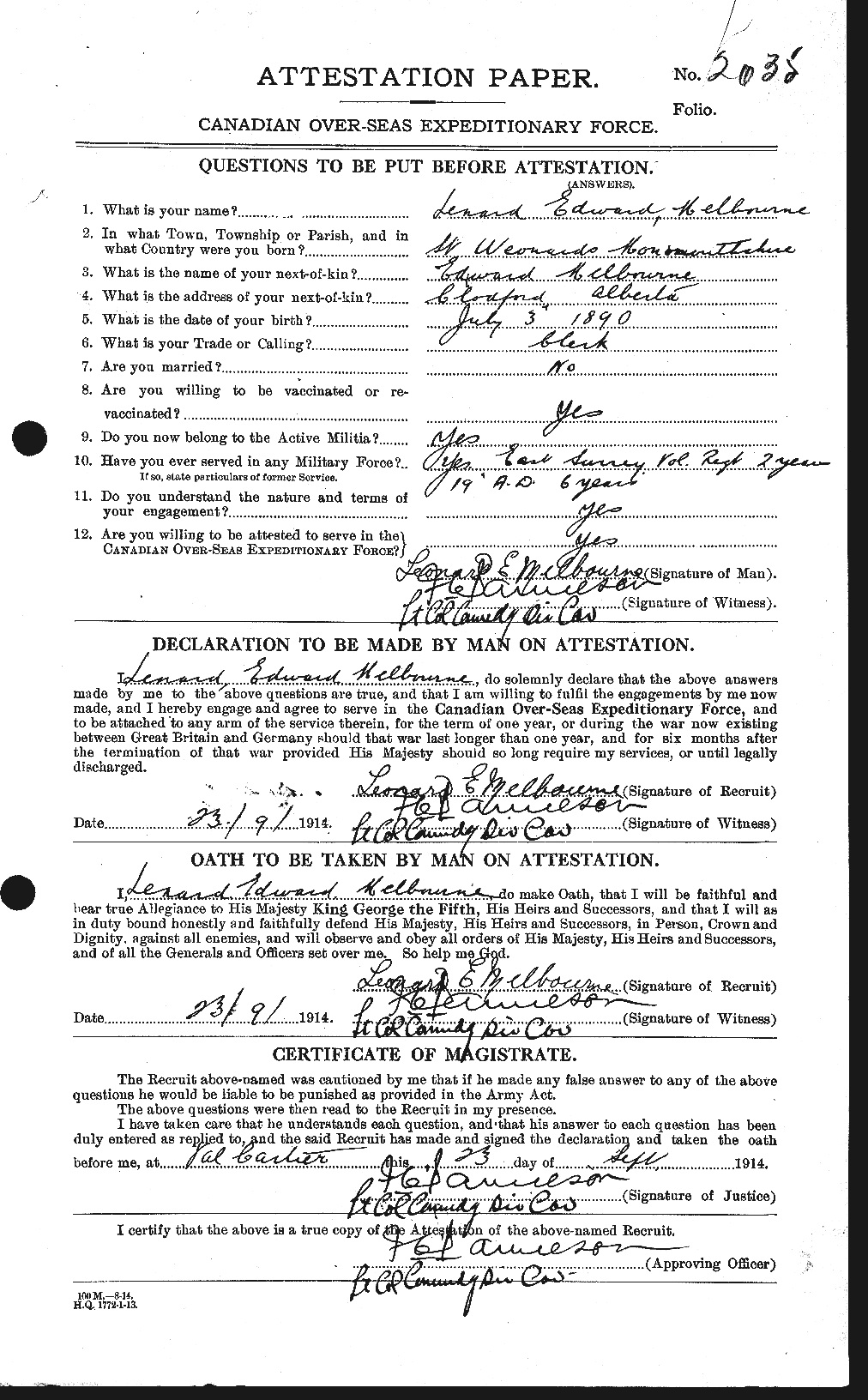 |
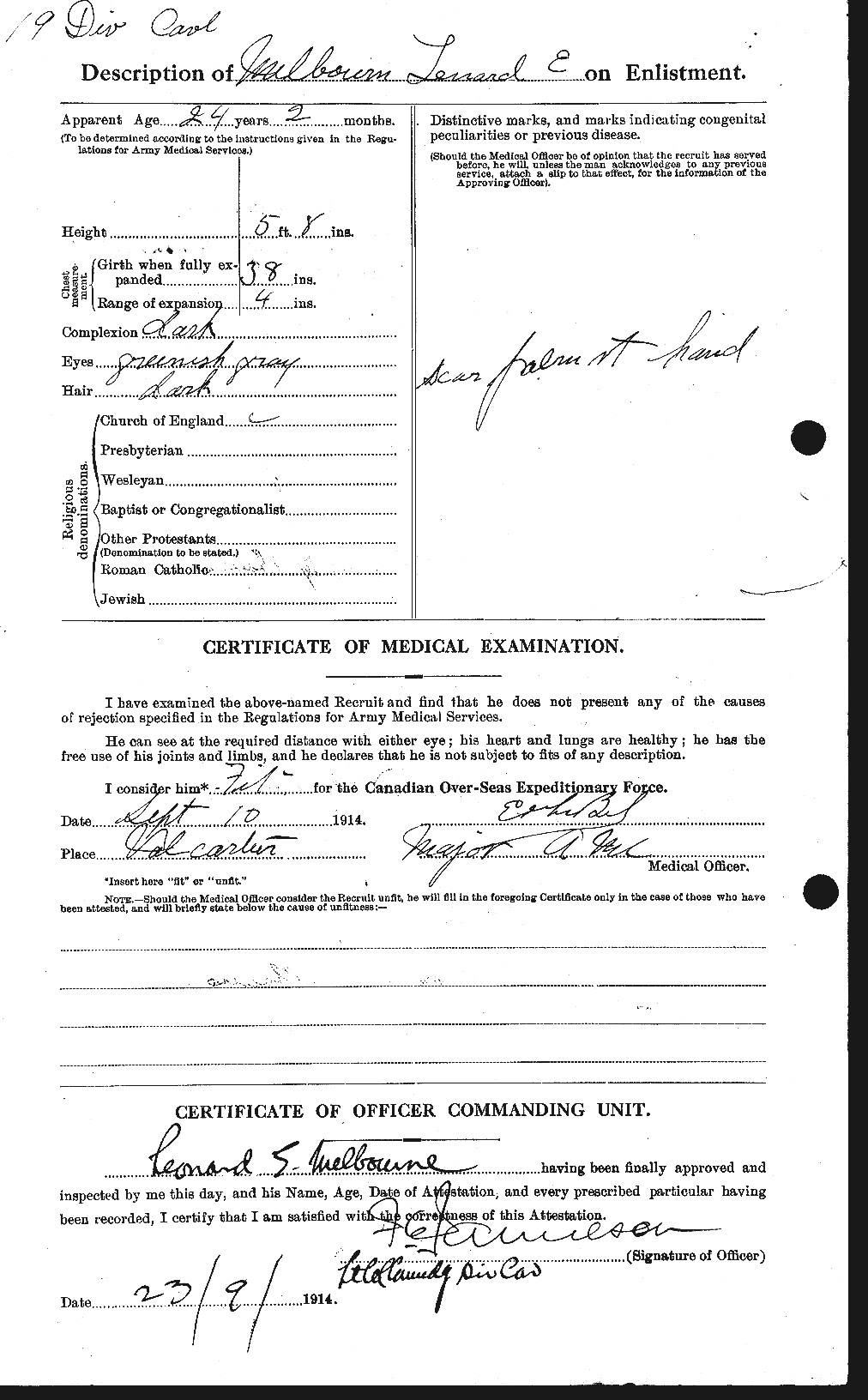 |
| This
record is dated the 23rd September 1914 and records
Leonard's joining the Canadian Expeditionary Force |
His
physical appearance is recorded here. He is 5' 8",
with a 38 " chest and greenish grey eyes and dark
hair. |
Life in England
The most detailed records for a soldier, at a personal level, are those related to health and pay as well as, while on active service a record of his promotions or appointments. These records exist in the archives, for Leonard, and we are able, by examining them, to determine something of where he was, what units he was with and, by inference, to deduce what his activities were.From Wood's diary we learn that the unit sailed on the Arcadia, a Cunard ship, on 3 October 1914, arrived at Devonport (Plymouth) England on the 14th and the unit then went to Salisbury plain for training until being sent to France on 3 February 1915. Wood's diary gives a trooper's view of what was happening. A more official record of the unit during this time period can be gleaned by reading the War Diary which is available on line at the Canadian Archives. In the war diary we learn that living conditions were rough, but in spite of this the unit maintained a vigorous training schedule with much emphasis on riding, use of the sword and after they were issued with them on 21 December, use of the short Lee-Enfield rifle. At this stage training started with elementary cavalry mounted movements as the Dragoons started to develop into a military unit for war. In addition to training they were tasked with policing responsibilities for the area with various patrols being assigned to these duties from time to time. Instruction was also given in map reading, reconesance patrolling, silent actions and dismounted actions, etc. Gradually the training become more complex and included interactions with other Canadian and Newfoundland infantry.
The unit was amongst the first of the Empire mounted troops to reach England and were much reviewed by senior commanders who were interested in knowing their capabilities. On 24 October, Field Marshal Earl Roberts (as remarked in the war diary, in "pouring rain"). On 3 November the squadron was reviewed by Their Majesties the King and Queen and Lt. Col. Jamieson was presented to them. On 8 November a small contingent was dispatched to London to participate in the "Lord Mayor's Show". On January 13 one of the officers, Lieutenant Edmiston was married to Mary Allen of Ottawa and the squadron provided escorts and honour guard for the couple. On January 20th and 21st they were inspected by two more generals. On February 4th they were again inspected by His Majesty the King.
Generally during this period in England the squadron had a holiday for a half day on Saturday and all day Sunday. It is likely that this practice allowed the troopers to leave base on some of these occasions. (indeed there are references to punishments for late returnees). Leonard had been away from England for a little more than 5 years. He had many cousins and aunts and uncles in the vicinity of Kingston-on-Thames. I am not aware of any specific records of his visits to these areas and people. However, Leonard's mother, Polly, had two sisters in the London area and his father, Edward, was one of eleven children. Although three of his grandparents were deceased by 1914 his maternal grandmother Elizabeth (nee Rogers) Strange was still alive and he may well have seen her. In addition to any leaves he might have had, it is possible that one or more of these people would have visited him at the barracks.
The First Period of Service in France
The 19th moved to France as part of the Canadian Cavalry Division on 8 February 1915. These were exciting times for the Dragoons and with this the war diary is suddenly much more verbose. We learn that they entrained at Tidworth (in Salsbury Plains -- still a British Army training area) and then went to Avonmouth (near Bristol) to ship to St. Nazaire (in Brittany, France) aboard HMT Rosetti. The crossing was not overly fast but the weather was fine and they disembarked on the 12th of February. In rain, they proceeded from the Bay of Biscay to Hazebrouck in France. The war diary is not specific but likely they traveled in the famed "40-8" transports of the French railway system -- that is 40 men or 8 horses to a carriage. The officers would have been in a passenger coach. Hazebouck, France is located about 18 miles to the southwest of Ypres, a major battle area throughout WWI. When they detrained they then moved a 2-3 miles closer to the front in the Borre-Pradelles area.
In this area they continued their training -- no doubt
with an increased intensity and a greater awareness of the
realities of war. They were within in sound of the guns.
They practiced musketry, sword handling, various mounted
formations, dismounting into action and so on. On the 20th
of February Sir john French, the commander of the British
Expeditionary Force (of which they were part). The 19th's
colonel, Lt. Col. F.C.Jamieson was in command of the
Divisional Mounted Troops.
This type of training, combined with sub-units gaining
some front line experience continued unabated for the next
several weeks. However they still observed "Sunday
routine" -- that is they had a day of comparative rest.
They moved from billets in one place to another. The war
diary records promotions, demotions and various other
personnel moves as well as describing problems with
billets and supplies. Included in these personnel comments
are the sentencing of 2012 Pte. Potter, R.H. to seven days
field punishment for being drunk in Sailly -- so clearly
the boys were getting away from the drudgery of training
and patrols on occasion.
It is perhaps relevant to pause and describe what the
19th were in fact doing as it related to the war. The
commanders of the British Expeditionary Force, at this
time and for much of the war, maintained a belief that
they could, by various means of assault break through the
German lines and, once that was done, would be able to
unleash the cavalry to penetrate into the rear areas of
the Germans and defeat the German army. Consequently, the
cavalry had a limited role and limited exposure to any
danger until such time as the break through occurred. This
did much to lengthen the wartime life span of members of
the cavalry!
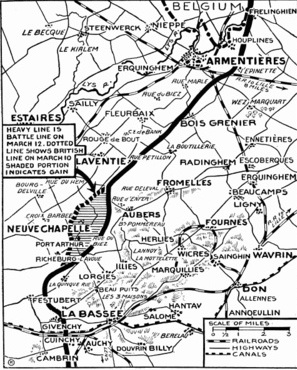 |
The first major offensive of the BEF to penetrate the German lines occurred at the battle of Neuve Chappelle between 10 and 13 March 1915. In this battle, although some gains were made by the BEF no breakthrough occurred. As a result, the planned attack by the 19th was cancelled. In this battle, the British forces were led by Sir Douglas Haig's first army consisting of 40,000 troops. They succeeded in capturing and holding the town of Neuve Chappelle, thereby removing a German salient into the British lines. The Dragoons were on stand by for most of the three days of the battle, their intended role is detailed in operational order 5 which is reproduced in the war diary. One can imagine the anticipation, and the fear, as the Dragoons prepared to attack with sword and Lee-Enfields so as to exploit the anticipated break through. That break through did not come and eventually they stood down and returned to billets. In the meantime, to capture this area (shaded in the map), which had a maximum penetration of two miles, Haig's army had suffered 11,200 casualties. There is no indication in the war diary of any casualties amongst the Dragoons. This battle, the first major attack on the western front, was typical of battles for the next three years. In general there were large numbers of troops involved with limited gains and heavy casualties. During the battle the Dragoons were on alert near Sailly, about 3 miles northwest of the battle area, ready to receive orders from divisional command. The watched aircraft and saw much artillery but saw no action themselves. |
| The Battle of Neuve
Chappelle |
As March progressed, the Dragoons continued their
training. The weather was occasionally severe with snow
reported on 19th March. The war diary reports the arrival
of more horses as well as men, promotions and continual
moves to different billets. And now the troopers are being
rotated into the trenches to get front line experience.
These deployments were of a training nature with the
troopers being paired with operational units. During this
period we also see records of troopers being assigned to
various police duties in the rear areas. We see some
evidence of casualties during this time but these are from
training injuries and not from enemy action.
The Second Battle of Ypres
April arrives and the routine continues: more training in
mounted drill, equitation and sword use, re-locations,
some policing duties and some exposure to conditions on
the line. By 18th April they find themselves billeted near
Poperinghe in Belgium, just to the northwest of Ypres.
They are again involved in training and in distributing
horses to the ammunition train and artillery.
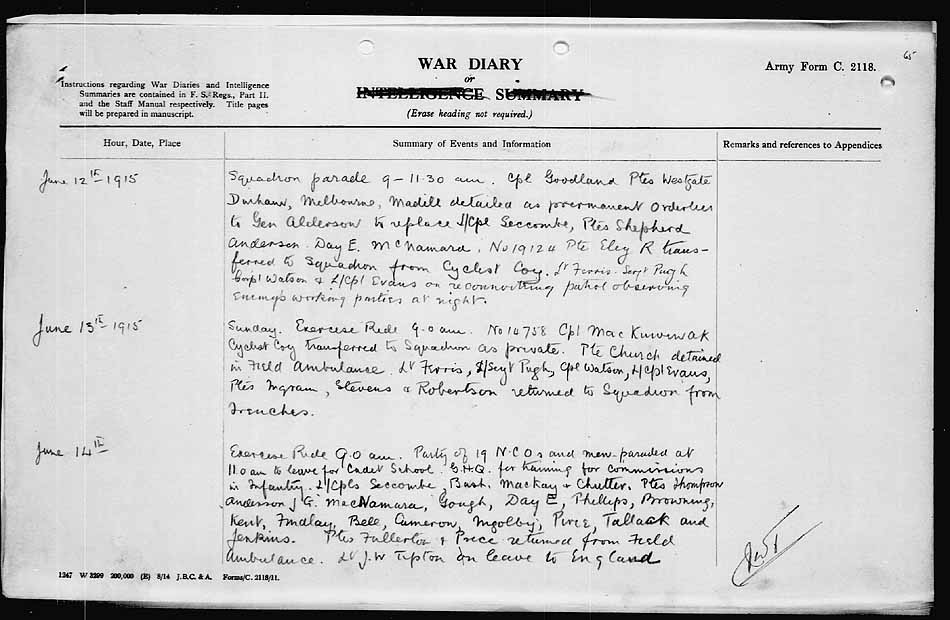 |
19th Dragoons War Diary Entry for June 12th, 1915Squadron parade 9 -
11:30 am. Cpl Goodland, Ptes. Westgate, Durham,
Melbourne, Madill detailed as permanent orderlies
to Gen. Alderson to replace L/Cpl Seccombe, Ptes.
Sheherd, Anderson, Day, E., McNamara. No 19124 Pte
Eley, R. transfered to Squadron from Cyclist Coy.
Lt. Ferris, Sgt. Pugh, Corp Watson and L/Cpl
Evans on reconnoitering patrol observing enemy's
working parties at night.
[Note: An orderly would have been an on-call soldier who ran dispatches and served as a duty person for miscellaneous duty for the Commanding Officer and/or his headquarters. This was usually a temporary assignment.] (click on image for larger copy) |
26/6/15 Transferred to #6 convalescent camp from #3 Field Ambulance with diarrhoea (in France)
14/9/15 Transferred to Canadian Army Corps HQ France
In Hospital and Recovery in England
11/3/16 He was admitted to hospital at Camiers with what was eventually diagnosed as nephritis (kidney inflammation).
19/3/16 Admitted to 1st Norfolk General Hospital Newcastle
4/4/16 Admitted to Hill house Con. Hospital Uxbridge
3/5/16 Admitted to Canadian Convalescent Hospital in Monks Horton, Kent for treatment of his nephritis
until 11/7/16
11/7/16 he was returned to duty and assigned to the Fort Gary Horse.
17/9/16 he was transferred to the 9th Bn.
With the 10th Battalion of the Canadian Army
27/9/16 he was transferred to the 10th Bn. and taken on strength there on 28/9/16
19/1/17 to 25/1/17 he was in hospital with influenza
5/5/17 appointed Lance/Corporal
16/6/17 appointed Acting Corporal with pay
5/7/17 promoted Corporal
18/7/17 award of Military Medal was gazetted for action on 28 April 1917 (Battle of Arras)
27/8/17 appointed Lance Sergeant
10/10/17 appointed Acting Sergeant with pay
29/10/17 to Corps School
2/12/17 granted 14 days leave in UK
13/1/18 promoted to Sergeant
4/9/18 gun shot wound right thigh --- during 100 days offensive
4/9/18 Admitted to 83 Gen Hospital Boulogne
| The
Marriage That Wasn't As we see, in his personnel records, Leonard was given permission to marry on ------. We also see that he is granted passage to Canada with a dependent. But what of this marriage? His xxx papers indicate the marriage is cancelled, but only by crossing it out. For most researchers this would be the end of the story -- he received permission to marry and the marriage never occurred. Interestingly we have two items of family history which relate to this wedding that never happened. On January 31st, 1916, Leonard's sister Elsie had married Leonard's school friend Frank. Frank had an older sister, Lillian, who was widowed in 1916; she was left with four children and no means of support. In letters between Frank and Lillian it was decided to send the older boy, Francis Fry, to Canada for a few years. In a letter to Lillian, dated XXXXX, Frank suggests that Francis might travel to Canada with Leonard and gives as a contact the name and address of the future bride, Miss Jacobs. Interestingly Frank's grandmother was Mary (nee Jacobs) and one wonders if this was a cousin? [Francis may or may not have met Miss Jacobs. He did travel to Canada, by himself at the age of 12, and joined the family of Frank and Elsie. Francis never returned to live in England. He would eventually become the Chief Scout in Canada and an ordained minister in the Anglican Church of Canada. He was presented to the Queen in 1957 at the Scout Jamboree in England] A generation and a war later, Leslie Scott, nephew of Leonard, also went to England, as an airman in the Royal Canadian Air Force. Shortly after arriving he was granted leave and went to visit family relatives; he had numerous aunts and uncles in south of England. Amongst those he visited were some in the Thames Ditton area who were vocally critical of the fact that he was the nephew of Leonard Melbourne who, engaged to be married, and with all arrangements in hand, had left the bride at the altar. |
granted permission to marry
confused by records at this time -- probably with 10th Bn in Germany with Canadian Occupation Army
25/7/19 - 4/8/19 returned to Canada on Saturnia -- Glasgow-Montreal
10/8/19 demobilization
Narrative
served with 10th Bn (1917), 21st Reserve Bn (on discharge) , Canadian Cavalry Brigade 26.6.15, Private in Lord Strathcona horse in 30/1/17 thru 1918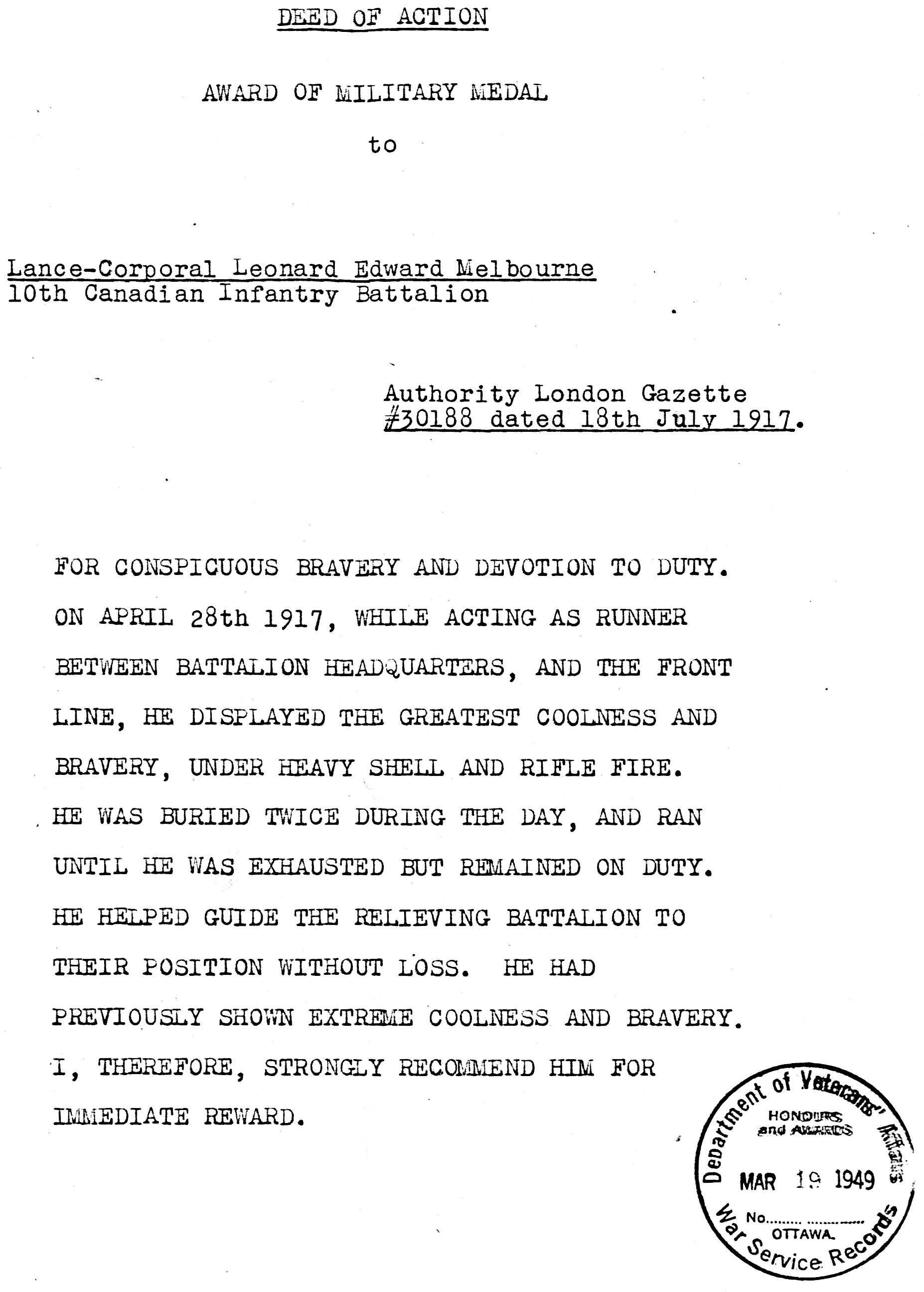 |
 |
| The
citation for the Military Medal awarded to Leonard |
The
London Gazette entry for his Military Medal |
 |
Medals Awarded To 2035 Sgt. Leonard Melbournefor service in WWI
Military Medal with Rosette (2nd award) -- for
bravery 1914-1915 Star -- awarded to those who served in
France before November 1, 1915 British War Medal -- awarded to all who served Victory Medal -- awarded to all who served The first of these, for bravery, was awarded
during the war, the remainder were awarded after
the war |
Letters from the front
Military Medal Citation
Leonard recieved two gun shot wounds during the war. These wounds left scars on his left and right legs as documented in his release notes
Time in England, France and Germany
1914-1915 Star
British War Medal
Victory Medal
(image to come)
Born: July 3, 1890 at St. Weonards, Wales.
2 years experience with the East Surrey Regiment (probably territiorials while at school in England)
6 years with the 19th Alberta Dragoons, prior to enlisting in 1914. (Leonard arrived in Canada in the spring of 1909. It is difficult to deduce that he had 6 years with the 19th Alberta Dragoons prior to enlistment in the fall of 1914)
at age 24 he was 5 ft 8 inches tall, chest of 38 inches, of dark complexion with greenish grey (hazel) eyes and dark hair.
On enrollment he was paid $1. per day plus a field allowance of $.10. Later in the war his pay as a sergeant was $1.50 per day. From 1 February he assigned $20/month of his pay to his mother Polly Elizabeth Melbourne
During WWII Leonard served in the Canadian Home Guard for a short time. :ater in his life he was a commissionaire in St. Johnn New Brunswick which is the place that he originally landed in Canada in 1909
He died in St. John in 1970 . . .
References and Credits
- Leonard and Shirley Melbourne for information on Leonard's life as well as photographs. Leonard and Shirley are respectively the son and daughter-in-law of Leonard Edward Melbourne, the subject of this record
- Archives Canada which provided a copy of Leonard's military record from WWI.
- Colin ? who maintains the
http://sites.google.com/site/the19thalbertadragoons/ww1
website, for information on the 19th Alberta Dragoons
- Glenbow Archives website: http://www.glenbow.org/collections/search/findingAids/archhtm/dragoons.cfm
- Wikipedia
for the map of the Neuve Chappelle battlefield.